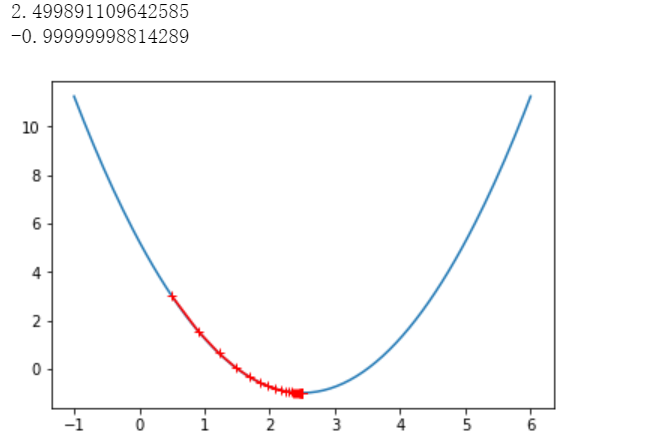在学习线性回归的时候很多课程都会讲到用梯度下降法求解参数,对于梯度下降算法怎么求出这个解讲的较少,自己实现一遍算法比较有助于理解算法,也能注意到比较细节的东西。具体的数学推导可以参照这一篇博客(梯度下降(Gradient Descent)小结 – 刘建平Pinard – 博客园)
一、 首先,我们用一个简单的二元函数用梯度下降法看下算法收敛的过程
也可以改一下eta,看一下步长如果大一点,算法的收敛过程
import numpy as np
import matplotlib.pyplot as plt
plot_x = np.linspace(-1,6,140)
plot_y = (plot_x-2.5)**2-1
#先算出来当前函数的导数
def dJ(theta):
return 2*(theta-2.5)
#梯度函数
def J(theta):
return (theta-2.5)**2-1
#初始化theta=0
#步长eta设置为0.1
eta = 0.1
theta_history = []
theta = 0
epsilon = 1e-8
while True:
gredient = dJ(theta)
last_theta = theta
theta = theta - eta*gredient
theta_history.append(theta)
if(abs(J(theta) - J(last_theta)) < epsilon):
break
print(theta)
print(J(theta))
plt.plot(plot_x, J(plot_x))
plt.plot(np.array(theta_history),J(np.array(theta_history)),color='r',marker='+')
plt.show()出来的结果如下:
二、在线性回归模型中训练算法–批量梯度下降Batch Gradient Descent
首先,构建一个函数
import numpy as np
import matplotlib.pyplot as plt
np.random.seed(666)
x = 2 * np.random.random(size=100)
y = x*3. + 4. + np.random.normal(size=100)
#然后改成向量的形式
X = x.reshape(-1,1)
plt.scatter(x,y)
plt.show()然后写实现梯度下降法求解我们构建的这个函数:
def J(theta , X_b , y):
try:
return sum((y-X_b.dot(theta))**2)/len(X_b)
except:
return float('inf')
#这里使用的是每次求一个参数,然后组合在了一起成了res
def dJ(theta, X_b ,y):
res = np.empty(len(theta))
res[0] = np.sum(X_b.dot(theta) - y)
for i in range(1, len(theta)):
res[i] = (X_b.dot(theta) - y).dot(X_b[:,i])
return res * 2 / len(X_b)
#这里也可以直接用矩阵运算求出所有的参数,效率更高
#return X_b.T.dot(X_b.dot(theta)-y)*2. / len(y)
然后把上面的过程封装成函数形式:
#把整个算法写成函数的形式
def gradient_descent(X_b, y ,inital_theta, eta ,n_inters = 1e4, epsilon = 1e-8):
theta = initial_theta
i_inter = 0
while i_inter < n_inters:
gradient = dJ(theta, X_b, y)
last_theta = theta
theta = theta - eta*gradient
if(abs(J(theta,X_b,y) - J(last_theta,X_b,y)) < epsilon):
break
i_inter += 1
return theta然后用我们实现的算法求解上面那个函数:
#这里加一列1
X_b = np.hstack([np.ones((len(x),1)), x.reshape(-1,1)])
#初始theta设置为0
initial_theta = np.zeros(X_b.shape[1])
eta = 0.01
theta = gradient_descent(X_b, y, initial_theta, eta)
theta输出结果如下:
array([4.02145786, 3.00706277])使用梯度下降法时,由于不同维度之间的值大小不一,最好将数据进行归一化,否则容易造成不收敛
三、在线性回归模型中训练算法–随机梯度下降Stochastic Gradient Descent
随机梯度下降法可以训练更少的样本就得到比较好的效果,下面用两段代码比较下。
这个就是之前的批量梯度下降,不过换了一个数据集
import numpy as np
import matplotlib.pyplot as plt
m = 100000
x = np.random.normal(size = m)
X = x.reshape(-1,1)
y = 4. * x + 3. +np.random.normal(0,3,size = m)
def J(theta , X_b , y):
try:
return sum((y-X_b.dot(theta))**2)/len(X_b)
except:
return float('inf')
def dJ(theta, X_b ,y):
return X_b.T.dot(X_b.dot(theta)-y)*2. / len(y)
def gradient_descent(X_b, y ,inital_theta, eta ,n_inters = 1e4, epsilon = 1e-8):
theta = initial_theta
i_inter = 0
while i_inter < n_inters:
gradient = dJ(theta, X_b, y)
last_theta = theta
theta = theta - eta*gradient
if(abs(J(theta,X_b,y) - J(last_theta,X_b,y)) < epsilon):
break
i_inter += 1
return theta%%time
X_b = np.hstack([np.ones((len(x),1)), X])
initial_theta = np.zeros(X_b.shape[1])
eta = 0.01
theta = gradient_descent(X_b, y, initial_theta, eta)
theta结果如下:
Wall time: 37.2 stheta:
array([3.00590902, 4.00776602])下面我们用随机梯度下降:
#这里每次求一行数据的梯度,所以后面不用除以m
def dJ_sgd(theta, X_b_i, y_i):
return X_b_i.T.dot(X_b_i.dot(theta) - y_i)* 2.
#随机梯度下降法学习率设置t0/(t+t1)这种形式
#由于梯度下降法随机性,设置最后的结果的时候只设置最大迭代次数
def sgd(X_b, y, initial_theta, n_iters):
t0 = 5
t1 = 50
def learning_rate(t):
return t0/(t+t1)
theta = initial_theta
for cur_iter in range(n_iters):
#下面是设置每次随机取一个样本
rand_i = np.random.randint(len(X_b))
gradient = dJ_sgd(theta, X_b[rand_i], y[rand_i])
theta = theta - learning_rate(cur_iter) * gradient
return theta
%%time
X_b = np.hstack([np.ones((len(x),1)), X])
initial_theta = np.zeros(X_b.shape[1])
theta = sgd(X_b, y, initial_theta, n_iters=len(X_b)//3)
结果如下:
Wall time: 481 mstheta:
array([2.93906903, 3.99764075])对比下两者的运行时间,随机梯度下降法计算量更小,时间也大大减少。
四、小批量梯度下降法-Mini-Batch Gradient Descent
这个完全按照自己理解写下,如果有大牛指点下不胜感激。
小批量梯度下降法主要在于每次训练的数据量不同,随机梯度下降是有一个样本就训练一次,小批量梯度下降是有一批样本训练一次,这里默认参数我给100
#这里每次求一行数据的梯度,所以后面不用除以m
def dJ_sgd(theta, X_b_i, y_i):
return X_b_i.T.dot(X_b_i.dot(theta) - y_i)* 2.
def sgd(X_b, y, initial_theta, n_iters,n=100):
t0 = 5
t1 = 50
def learning_rate(t):
return t0/(t+t1)
theta = initial_theta
for cur_iter in range(n_iters):
#下面是设置每次随机取一个样本
for i in range(n):
rand_i = []
rand_i_1 = np.random.randint(len(X_b))
rand_i.append(rand_i_1)
gradient = dJ_sgd(theta, X_b[rand_i], y[rand_i])
theta = theta - learning_rate(cur_iter) * gradient
return theta然后还是用之前的数据集测试下:
%%time
import numpy as np
X_b = np.hstack([np.ones((len(x),1)), X])
initial_theta = np.zeros(X_b.shape[1])
theta = sgd(X_b, y, initial_theta,n=5, n_iters=len(X_b)//3)结果如下:
Wall time: 643 ms这里每次给5个样本,耗费的时间还是很长的,不知道是不是代码写的有问题。
结果来看是对的:
array([2.96785569, 4.00405719])今天的文章梯度下降算法Python代码实现–批量梯度下降+随机梯度下降+小批量梯度下降法分享到此就结束了,感谢您的阅读。
版权声明:本文内容由互联网用户自发贡献,该文观点仅代表作者本人。本站仅提供信息存储空间服务,不拥有所有权,不承担相关法律责任。如发现本站有涉嫌侵权/违法违规的内容, 请发送邮件至 举报,一经查实,本站将立刻删除。
如需转载请保留出处:https://bianchenghao.cn/9689.html


